

Disha Gupta


In the rush to create and launch a corporate L&D strategy, enterprises often lose sight of what is important for employees. Training must be contextual to employees, built around their needs, and help them overcome their day-to-day challenges.
However, the importance of everyday work trumps learning. The urgency of completing your expected responsibilities and tasks is more important than learning and development.
But what if you could embed learning into everyday workflows without disrupting employee output? This is the concept of learning in the flow of work, which is disrupting the $200 billion corporate training market.
The “learning in the flow of work” approach to employee training and development was first coined by Josh Bersin in 2018. It focuses on learning experiences that empower employees with the right performance support, materials, and reinforcement training at the moment of need.
This type of employee training provides contextual training that makes learning a continuous effort, always happening as your employees conduct their work.
In this article, we’ll discuss the concept of learning in the flow of work, the challenges of enabling embedded learning, and how you can utilize emerging technologies like Whatfix to enable your employees with in-app guided experiences and on-demand support – all integrated directly with their digital business processes and tasks.
Learning in the flow of work refers to the integration of learning activities and resources directly into the daily workflows of employees. Rather than having separate training sessions or dedicated learning time, this approach seamlessly embeds learning opportunities within the natural flow of employees’ work.
It aims to provide just-in-time support, relevant knowledge, and learning resources that are readily accessible when needed. Learning in the flow of work emphasizes the idea that learning should be a continuous and integrated part of the work process, enhancing productivity, performance, and employee development.
The 70-20-10 Model for corporate learning and development is an evidence-backed research model that breaks down how employees learn.
It states that employees acquire 70% of their knowledge from on-the-job experiences and hands-on learning, 20% from social learning and interacting with colleagues, and 10% from more formal professional training and development.
Learning in the flow of work uses this breakdown to its advantage by aiding employees in their daily tasks and workflows with embedded learning experiences and contextual help.
To embed effective learning in the flow of work experiences into your employees’ workflows and tasks, a few fundamental aspects must be met:
Learning in the flow of work offers a range of corporate benefits that contribute to organizational growth, employee development, and overall success. A few of the key benefits include:
Delivering training that’s more relevant to employees’ roles and faster to complete results in higher learner engagement and faster skill competency naturally. By providing learning opportunities within their daily tasks, employees feel more connected to their work and are motivated to improve their knowledge and skills continuously. This higher level of engagement translates into increased job satisfaction, productivity, and employee retention.
While traditional learning will still be utilized for more intensive training experiences and needs (like employee onboarding or new software training), learning in the flow of work works together with traditional learning methods. Employees can acquire large chunks of knowledge in these more classroom or traditional learning sessions.
Then, by integrating in-app nudges, timely support, and other embedded forms of learning helps employees put this training into practice through small micro-reinforcements. This learning happens directly in employees’ daily workflows, while they’re completing tasks. This builds new competencies, ensures business compliance, drives process adoption, and improves knowledge retention.
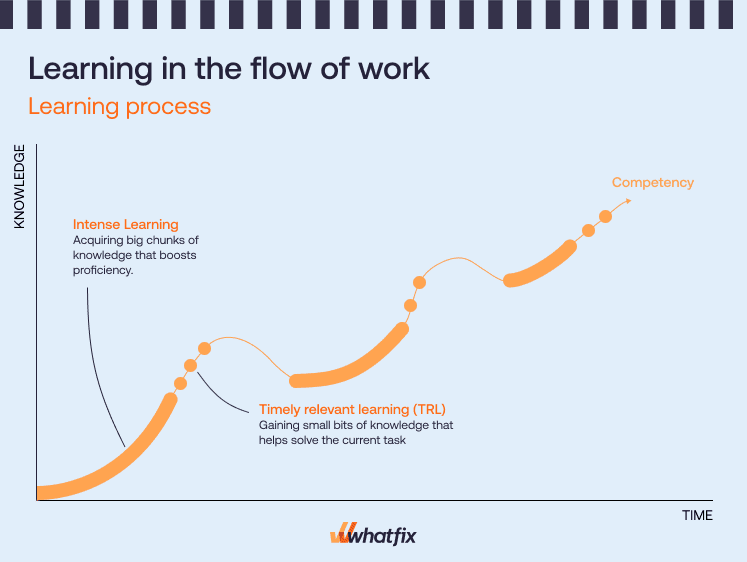
When learning is integrated into work processes, employees can quickly acquire the necessary knowledge and skills to address challenges and perform tasks more effectively. The just-in-time nature of learning in the flow of work ensures that employees have the resources they need at the moment of need, resulting in improved efficiency and increased productivity.
By emphasizing continuous learning within a work environment, organizations can foster a strong learning culture. Employees become more proactive in seeking knowledge, sharing insights, and embracing a growth mindset. A continuous learning culture fuels innovation, agility, and a commitment to ongoing improvement at all levels of the organization.
Integrating learning into the flow of work is more cost-effective as compared to traditional training methods. By leveraging existing work platforms and tools, organizations can eliminate or reduce the need for separate training sessions, travel expenses, and dedicated training facilities. This results in significant cost savings while promoting ongoing employee development.
While learning in the flow of work offers significant benefits, there are also challenges that organizations face when implementing this approach to L&D. A few common challenges include:
Shifting from traditional training methods to a learning in the flow of work approach may require a cultural shift within the organization. Resistance to change and reluctance to adopt new practices can be a significant challenge. Organizations need to effectively communicate the value, benefits, and purpose of this approach to gain buy-in from employees and stakeholders.
Lack of access to appropriate technology or inadequate infrastructure can hinder the integration of learning resources within everyday work platforms. Organizations must ensure that employees have access to the necessary tools and technologies to facilitate learning in the flow of work. benefits, and purpose of this approach to gain buy-in from employees and stakeholders.
Addressing the diverse learning needs and preferences of employees can be challenging when implementing learning in the flow of work. Designing learning experiences that cater to individual needs while ensuring consistency and standardization across the organization requires careful planning and customization options. Enterprises must create learning cohorts based upon individual needs and learning styles of effectively implement a learning in the flow of work model.
Ensuring the accuracy and relevance of learning resources integrated into work platforms requires effective enterprise knowledge management. This includes keeping all process and training documentation updated and accessible, as well as having self-help knowledge centers like a knowledge base or internal wiki for employees to find the performance support they need. Regular updates and quality control measures need to be implemented to provide employees with up-to-date and reliable help and information.

Implementing learning in the flow of work requires a thoughtful approach and careful planning by enterprise L&D teams. Here are some key steps to effectively implement this learning approach.
Conduct a thorough training needs analysis of the the biggest learning gaps in your organization and identify areas where learning can be integrated into your employees’ daily work processes. Understand the skills and knowledge gaps that need to be addressed for improved performance.
Identify specific work tasks or processes where learning can be integrated into the workflows themselves with helpful, embedded guidance, tooltips, field validations, and more. Determine the key points where employees can benefit from learning support or guidance in their workflow.
You can embed performance support and workflow guidance directly into your applications with a digital adoption platform like Whatfix. Whatfix enables L&D teams with a no-code editor to create and launch in-app flows, smart tips, task lists, pop-ups, self-help wikis, and more – all providing moment of need learning, in the flow of work, that’s contextual to your employees tasks and workflows.
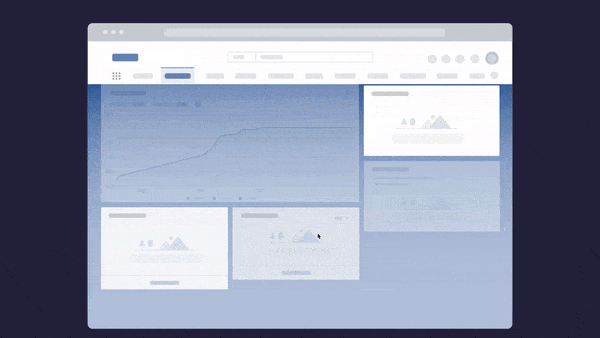
Josh Bersin, an L&D analyst first credited with creating the “learning in the flow of work” concept, believes that to get continuous learning right, enterprises must follow a four-approach framework. Those four approaches include:
Microlearning is an approach to learning that breaks training content down into small, bite-sized information modules. Smaller learning sessions, aligned with the identified work tasks, provide all information necessary for learners to achieve a specific training objective in a short window of time. Microlearning is more effective because learners apply the skills they’ve acquired before they lose attention, thus leading to higher rates of learning retention.
Learners need to be able to find the information they are looking for whenever they desire it, on whatever platform, and in the right context. Understanding your employees’ capabilities and how they consume information is critical to delivering the right learning experience at the right time.
Leverage digital tools and technologies to facilitate learning in the flow of work. Examples of L&D tools that enabled learning in the flow of work include:
Ensure that employees have the necessary support and self-help resources to access training materials and receive assistance when and where they need it. Offer contextual guidance on how to navigate the learning resources and promote self-directed learning.
With a DAP like Whatfix, enable employees with an in-app resource center (we call it Self Help) that integrates with your internal knowledge repositories like internal wikis, training resources, SOPs, LMS modules, onboarding materials, and more. Employees are enabled with contextual help depending on where they are in an application and their role.
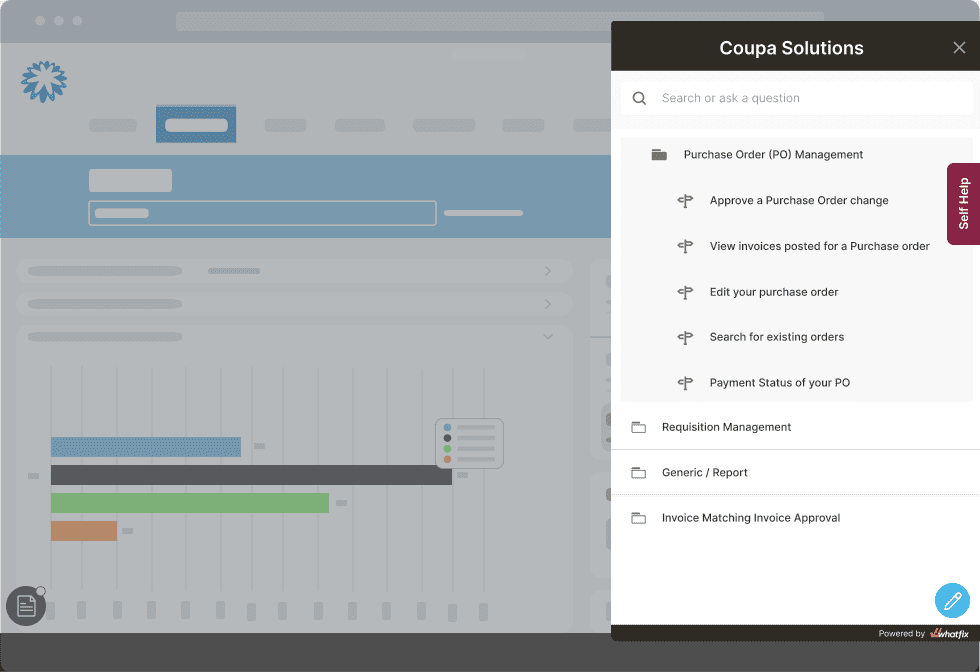
Whatfix Self Help is now powered by AI, allowing employees to search for any contextual issue or help documentation they need – right inside the application they’re using.
Whatfix AI instantly generates an answer to their contextual query based on your internal documentation – and provides citation links for employees to learn more about a topic or can prompt an in-app guided experience that walks employees step-by-step through a process.

Remember that continuous learning is not just about the technology or content formats but also about humans and culture. You should work towards building an organizational culture that encourages the democratization of learning. Everyone should be empowered to share knowledge via the likes of mentorship and connected internal social networks – which helps to build a learning organization.
Learning in the flow of work both supports employees to drive productivity and empowers organizations to achieve business outcomes – all without sacrificing learning.
Here are four examples of organizations enabling their employees with embedded learning and interactive support directly in their daily workflows with Whatfix.
Contract management is better at Ferring Pharmaceuticals. With Whatfix’s connected digital adoption platform (DAP) guided Ferring employees through the complexities of thousands of Icertis contract tasks and workflows, improving the user experience and accelerating contract execution. This freed up more time for users to focus on their business and allowed the Legal Operations team to spend more time on legal services innovation..
Contextual information, step-by-step instructions, and a knowledge repository were all available in the moment of need. This empowered Ferring to deliver an agile and improved Icertis user experience, ensure contract compliance, and reduce the volume of contract support inquiries.
With Whatfix, Ferring:
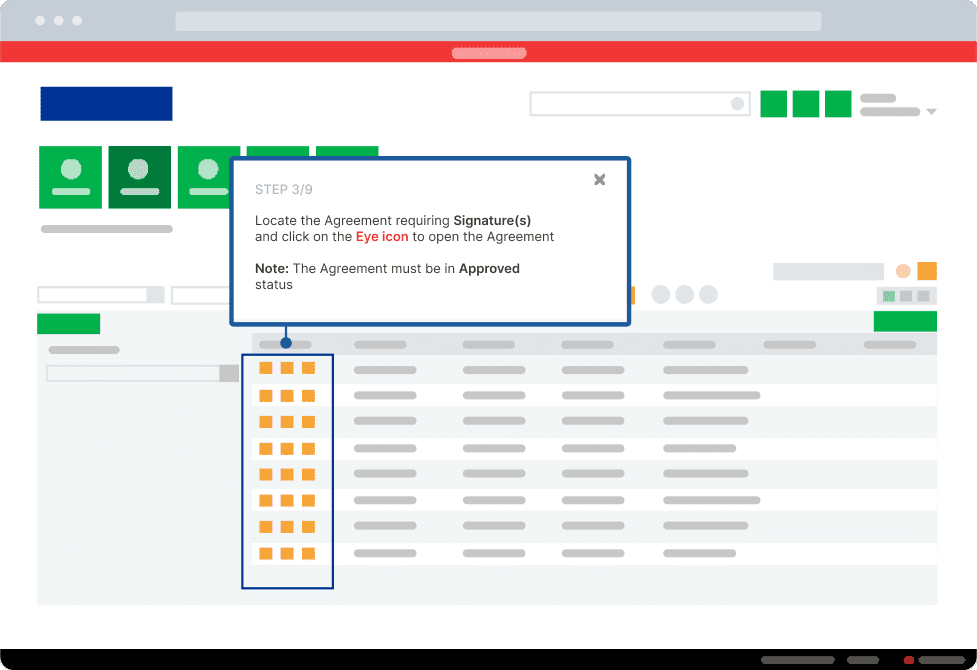
Renewable energy giant REG lowers time-to-proficiency on its enterprise CRM, ERP, and other applications, while also reducing daily IT support queries and human errors, all with Whatfix’s in-app guidance, continuous learning, and on-demand self help. With REG, Whatfix enabled employees with in-app learning on its Saleforce CRM and JD Edwards ERP processes, reducing time-to-proficency by 50% – a 3 month reduction.
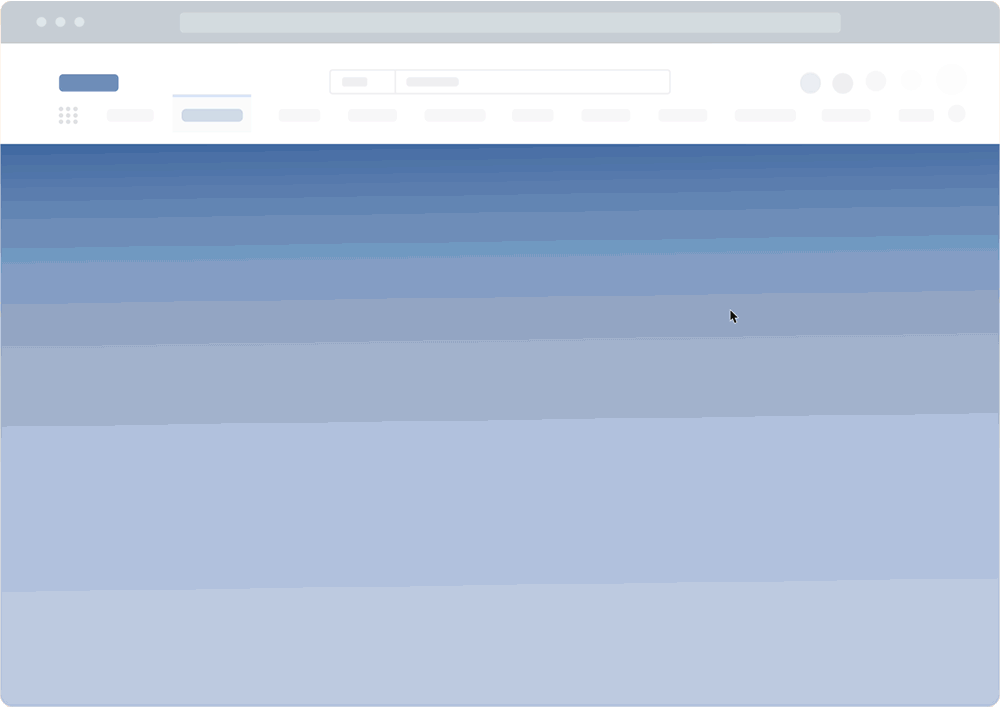
Sentry Insurance used Whatfix to build personalized, in-app learning across Workday and seven other internal and customer-facing systems, including customer administration, policy management, claims, and a customer portal. Intuitive guidance for 2,000 associates and 75,000 portal customers drove customer-centric policy administration, agile claims processing, and sales growth.
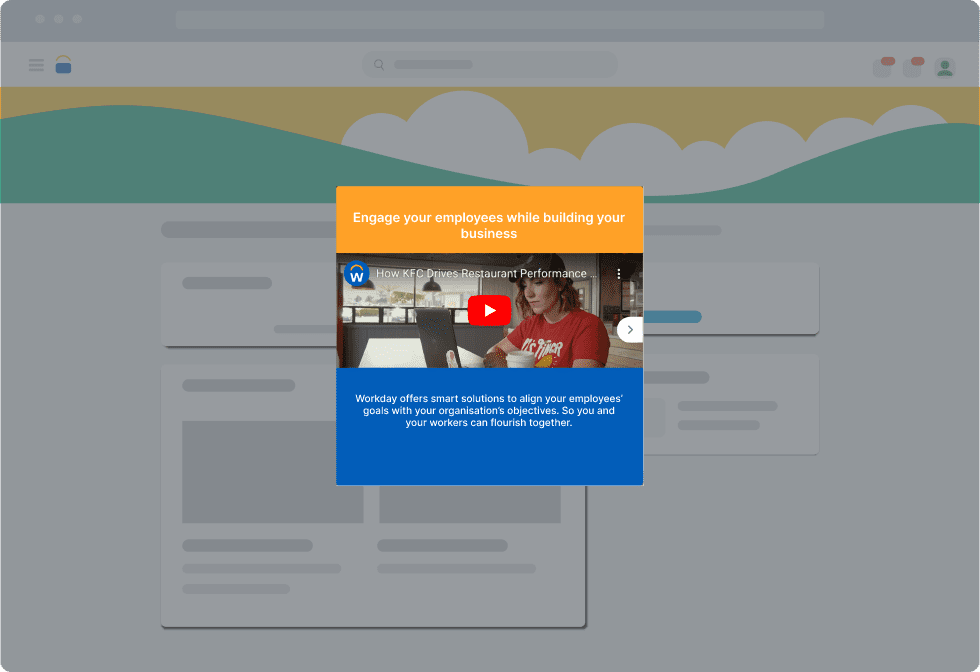
Learning in the flow of work also drove training retention for knowledge workers, providing embedded mediums for Sentry to drive company news, change awareness, and knowledge transfer.
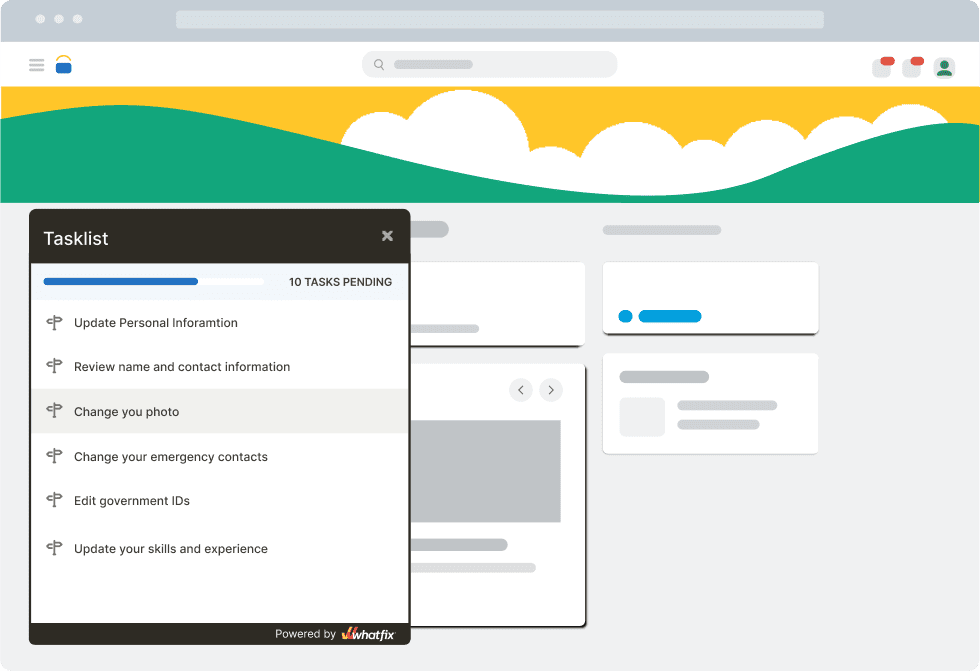
Global staffing and recruiting company Hays accelerates adoption of its custom-built CRM with Whatfix. With Whatfix, Hays created in-app guided onboarding, continuous learning, and on-demand help to 1,500 users – streamlining communications, processes, and digitalization efforts.
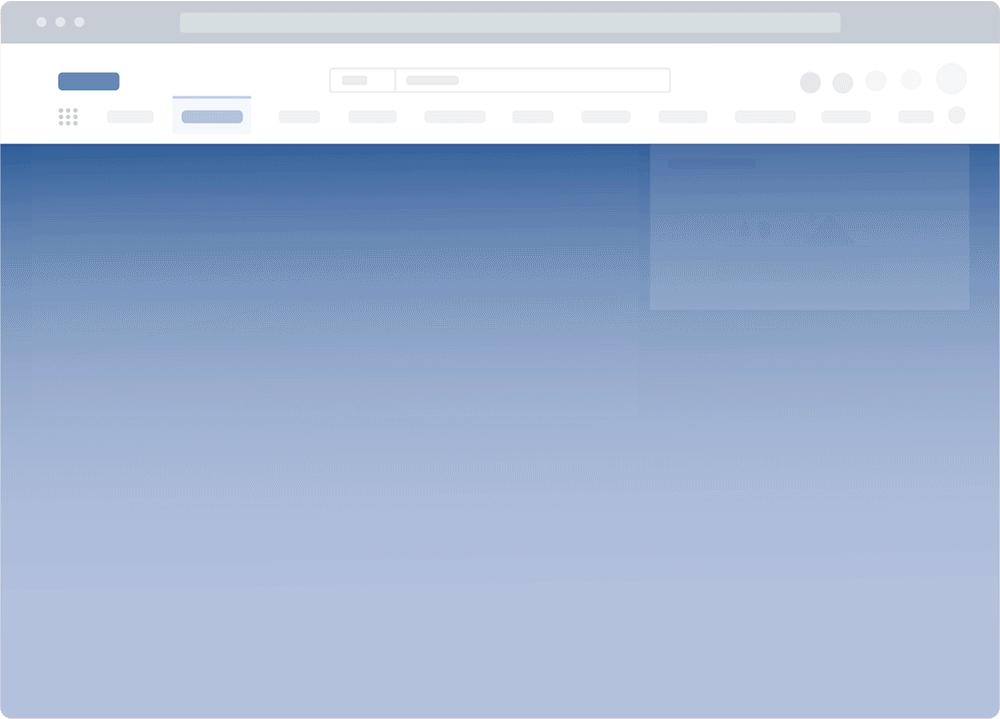
With in-app guided experiences embedded into its employees daily CRM workflows, CRM engagement improved by 500% and Hays saw a 75% reduction in CRM-related IT support tickets.
Learning in the flow of work is a crucial concept for businesses looking to improve the impact of their training and maximize ROI. By providing the right information at the right time, employees are empowered to implement their learnings in real-time, which translates into higher engagement with better business performance.
To get the most value from learning in the flow of work, implement a training tool like Whatfix that provides real-time guidance and on-screen support within any software or application employees use in their daily workflow.
Whatfix is a digital adoption platform (DAP) that lies on top of any software or application to provide interactive in-app guidance in the form of helpful nudges and interactive walkthroughs to facilitate employee onboarding, drive change management and digital transformation, provide on-demand performance support, and improve knowledge sharing.
Furthermore, Whatfix is a no-code platform that empowers L&D teams to create in-app experiences without the need for engineering support. It also provides advanced employee analytics on software engagement, training effectiveness, and onboarding completion.
Through interactive walkthroughs, tooltips, and performance support tools, DAPs offer contextual information and just-in-time learning resources that help employees learn and utilize the tools effectively while performing their tasks.
Ready to enable your employees to learn in the flow of work? Request a Whatfix demo now!
Software clicks better with Whatfix's digital adoption platform
Enable your employees with in-app guidance, self-help support, process changes alerts, pop-ups for department announcements, and field validations to improve data accuracy.
Thank you for subscribing!